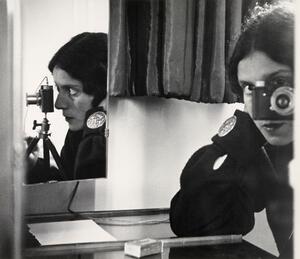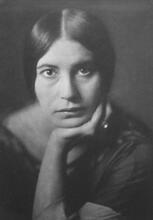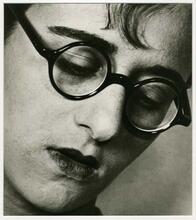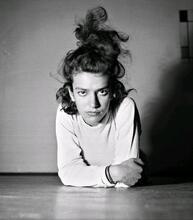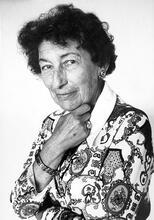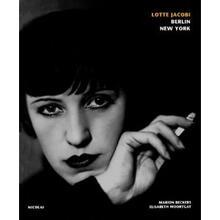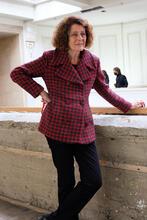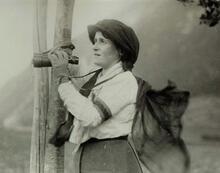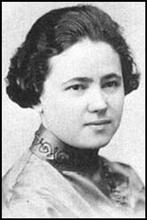Ilse Bing
Ilse Bing’s experiments with the new Leica camera and darkroom techniques like polarization and cropping helped break down the boundaries between artistic photography, photojournalism, and commercial work. Bing studied mathematics and physics at the University of Frankfurt and art history in Vienna before becoming a photo essayist for the Frankfurter Illustrierte. She moved to Paris in 1930, immersing herself in the avant-garde movement and working for fashion designers and magazines like Harper’s Bazaar. In 1937, Beaumont Newhall included her in his groundbreaking photography exhibition at MOMA. After she was imprisoned by the Vichy government in 1940, she immigrated to New York. In 1959, she continued to make art by creating collages, often using her old photographs, and discovered a new passion, writing poetry.
In Paris in 1932, a critic called Ilse Bing the “Queen of the Leica.” Her work in photojournalism, fashion, and advertising utilized this new camera, fast film, and darkroom techniques of polarization and cropping. The resulting photographs diminished the distinction between commercial and artistic photography. Her work was highly influential in France in the 1930s when many émigré artists were energized by the cross fertilization of disciplines that contributed to modern photography.
Early Life and Education
Louis and Johanna (Katz) Bing’s daughter was born in Frankfurt on March 23, 1899. They were affluent and occasionally observant Jews who provided their daughter with a liberal education including music and art. In 1920, Ilse Bing entered the University of Frankfurt to study mathematics and physics. By 1923, her interests had changed, and she was in Vienna studying art history. She returned to the University of Frankfurt in 1924 to pursue a doctorate. In 1929, she purchased a new Leica, became devoted to photography, and abandoned her studies. Family and friends ostracized her for working at the Frankfurter Illustrierte as a photo essayist, a job they considered to be menial. She immersed herself in this new work and in developing her artistic abilities. As Ilse Bing told Nancy Barrett in a 1985 interview, “I didn’t choose photography, it chose me.... Now over 50 years later, I can look back and explain it. In a way it was the trend of the time; it was the time when you started to see differently ... the beginning of the mechanical device penetrating into the field of art.” She struggled to fuse representation and abstraction. Her work consistently challenged the line between art and commercial photography. She saw beauty in subjects others did not notice. She focused attention on materials, surfaces, architectural spaces, nuances of movement, and texture. Her lifelong love of mathematics and science has always informed her work.
Work in Paris
Moving to Paris in 1930, Bing instantly loved the city. She participated in the avante-garde movement that affected all aspects of creative life: exhibitions, journals, performances. The leaders were largely self-taught émigré artists such as Man Ray, André Kertesz, Paver Tchelitchev, Germaine Krull, and Florence Henri. Tchelitchev commissioned Bing to photograph a ballet Errante, using only ambient light. The results were acclaimed. The Leitz Corporation was so impressed that they sent her new wide-angle and telephoto lenses for experimentation. She worked for the fashion designer Schiaparelli, Harper’s Bazaar, Vu, and various weekly newspapers. After Hitler’s rise to power in 1933, she refused to work for German magazines. She built a successful career doing architectural, advertising, theater, and portrait photography. Her art photography was shown in leading galleries and exhibitions. By 1932, her work was exhibited in New York at Julien Levy’s gallery.
In 1936, she was invited to New York by the author Hendrik Willem Van Loon. Her popularity brought commissions, a one-person show, meetings with photographer Alfred Stieglitz, and a job offer at Life magazine. She returned to Paris in 1937 to marry Konrad Wolff, a pianist and musicologist. That year Beaumont Newhall selected her work for his important 1937 photography exhibition at the Museum of Modern Art. Bing did less work in the late 1930s, describing herself as fulfilled and accomplished, yet searching for something different. In 1940, she was jailed in France by the Vichy government at Camp Gurs, but she was able to immigrate to New York the following year.
Immigration to New York and Career Successes
Ilse Bing struggled to forge a new life among many talented refugees. By 1947, she had found a new style using an electronic flash and a large-format Rolleiflex. Her scale was larger, and her subjects projected a sense of isolation and stillness. A decade later she was working exclusively in color, doing all her own developing. Her work was highly praised, but in 1959 she stopped photographing. Instead, she wrote poetry in German, French, and English and constructed collages often using old photographs. Bing’s work was rediscovered after being included in a 1976 exhibition at the Museum of Modern Art and a subsequent exhibition at the Witkin Gallery. A retrospective exhibition of her work was organized by the New Orleans Museum of Art in 1985, followed by exhibitions at the International Center of Photography in New York, the Baltimore Museum, and Musée Carnavalet in Paris. In 1993, the National Arts Club awarded her their Gold Medal for photography. Bing died in New York on March 10, 1998, just before her ninety-ninth birthday.
Ilse Bing’s legacy is her photographs. Many images fascinate because they eloquently represent vanished lives, events, and places. She developed a mature style characterized by strong diagonals and an overhead axis, reflective surfaces, focused pools of light, clarity of textures, and regrouping of real objects out of their context. Her photographs convey a strong sense of time continuing, not as a moment frozen. Her dominant aesthetic is grounded in constructivism, but in Paris she forged this with a sensibility learned from the surrealists, dadaists, and neo-romantics. After fifty years, her vision remains compelling. She leaves work rich in craftsmanship and aesthetics upon which others can build. She was an artist who seized the moment and is recognized as a pioneer in the birth of modern photography.
Barrett, Nancy C. Ilse Bing: Three Decades of Photography (1985).
Bing, Ilse. Numbers in Images (1976), and Words as Visions (1974).
Rosenblum, Naomi. A History of Women Photographers (1994).
Sullivan, Constance. Women Photographers (1990).
Witkin, Lee D. A Ten Year Salute (1979).

